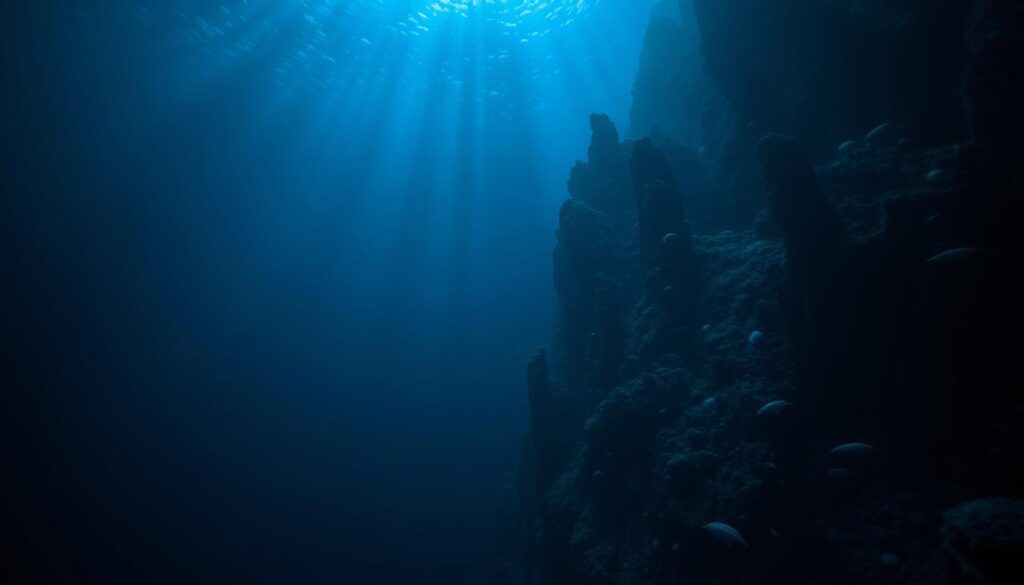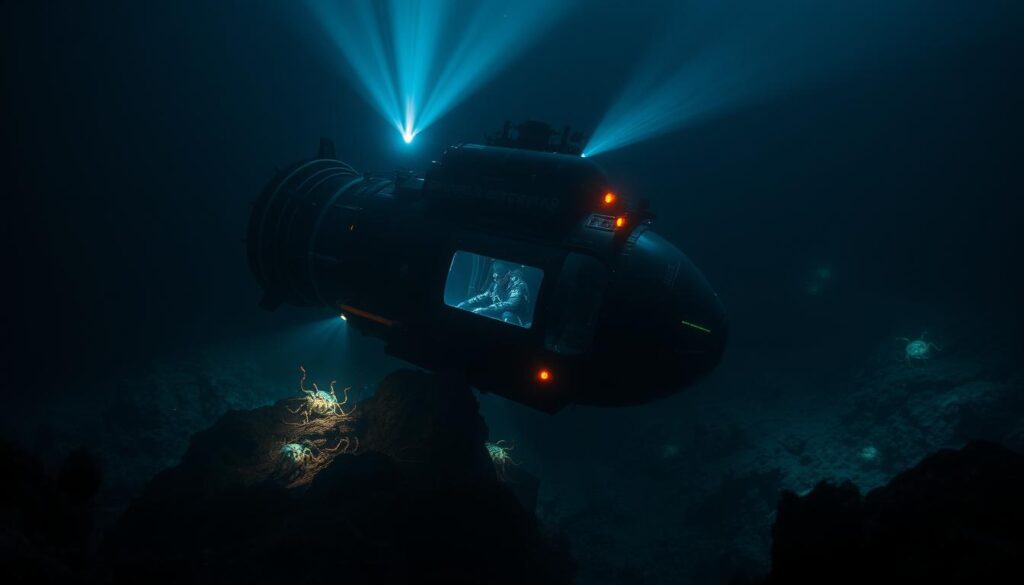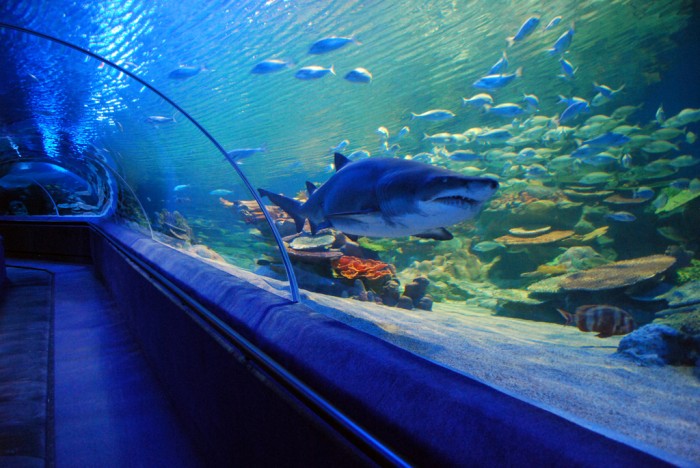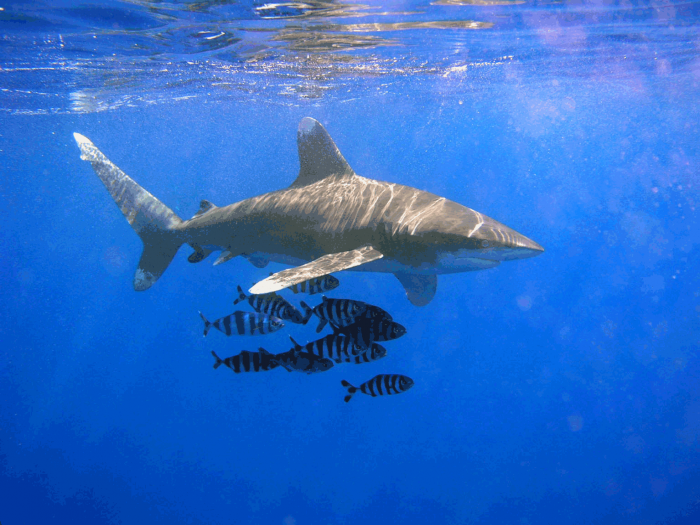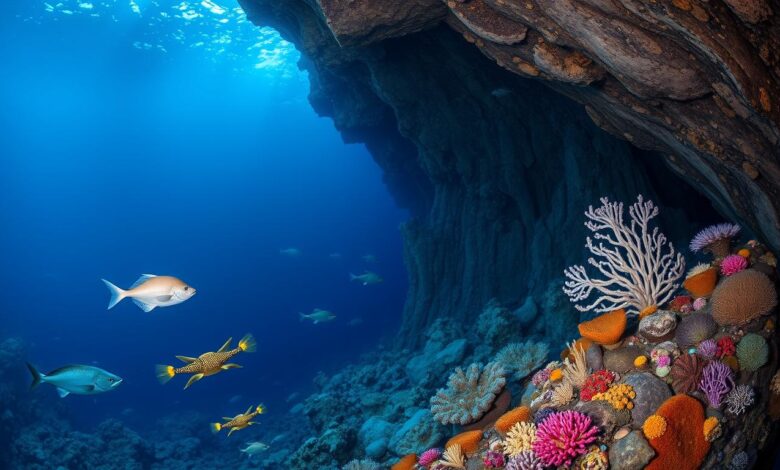
The Mariana Trench is the deepest spot in the ocean, going down over 36,000 feet. It’s deeper than Mount Everest, the tallest mountain. First found in 1875, it has fascinated scientists and explorers for years.
This trench is where the Pacific plate meets the Mariana plate, pushing one under the other. It’s a deep dive into Earth’s past and a key spot for science.
The Mariana Trench is home to unique marine life that can handle extreme pressure and cold. It inspires new discoveries and connects us to our planet’s wonders. From deep-sea expeditions to finding new species, it keeps challenging and intriguing us.
It links the Earth’s depths to our understanding of the world. The Mariana Trench is a mystery and a marvel that pushes us to learn more.
Introduction: Unveiling the Deepest Place on Earth
The Mariana Trench is the deepest spot in the Pacific Ocean. It’s full of mystery and wonder. Scientists and explorers have been drawn to it for years. They want to learn about its deep-sea life and complex geology.
Why the Mariana Trench Captivates Scientists and Explorers
The trench stretches over 1,500 miles. It’s where the Pacific plate meets the Mariana plate, creating a deep chasm. This place is crucial for learning about marine life, geology, and ocean phenomena.
Overview of Its Location and Significance
The Mariana Trench is near the Mariana Islands in the Pacific. It’s the deepest trench on Earth, with the Challenger Deep reaching over 36,000 feet deep. This happens because of the tectonic plates moving under each other.
1. The Mariana Trench is the Deepest Oceanic Trench on Earth
The Mariana Trench is the deepest part of our ocean, reaching down about 36,070 feet (10,994 meters) at the Challenger Deep. This depth was first found in 1960 by the Trieste bathyscaphe, a special submersible. Later, explorers like James Cameron and Victor Vescovo went there and confirmed it’s the deepest spot on Earth.
Understanding Its Depth and How It Was Measured
The Mariana Trench is so deep, it could swallow Mount Everest whole, with over 7,000 feet of water on top. The Titanic’s wreckage, at about 12,500 feet deep, is almost three times shallower than the Challenger Deep.
Comparison with Other Deep Ocean Trenches
Though the Mariana Trench is the deepest, other trenches are also very deep. The Tonga Trench is the second deepest, going down 35,702 feet. The Galathea Depth in the Philippine Trench is third, at 34,580 feet. The Kuril-Kamchatka Trench in the Pacific Ocean is also very deep, reaching 34,449 feet.
| Trench Name | Depth (feet) | Depth (meters) |
|---|---|---|
| Mariana Trench (Challenger Deep) | 36,070 | 10,994 |
| Tonga Trench | 35,702 | 10,882 |
| Galathea Depth (Philippine Trench) | 34,580 | 10,540 |
| Kuril-Kamchatka Trench | 34,449 | 10,500 |
These deep areas make up about 45% of the ocean’s depths, with some trenches over 6,000 meters deep. Scientists keep exploring these deep places to learn more about the ocean.
2. It Was Formed by Subduction Zones
The Mariana Trench is the deepest part of the ocean. It was made by the powerful forces that shape our planet. This deep trench was formed through subduction. This means the dense Pacific plate goes under the smaller Mariana plate.
As the Pacific plate sinks into the Earth’s mantle, it makes a deep, narrow trench. This is how the Mariana Trench was created.
The Tectonic Plates Involved in Its Formation
The Mariana Trench is where two big tectonic plates meet – the Pacific and the Mariana plates. The Pacific plate is older and heavier. It is being pushed under the lighter Mariana plate.
This makes a deep ocean trench. The process of subduction also causes volcanic arcs and lots of earthquakes in this area.
How Subduction Creates Deep Ocean Trenches
- When the Pacific plate goes down, it makes a deep, narrow hole in the ocean floor – the Mariana Trench.
- Subduction also leads to volcanic activity. The Mariana Volcanic Arc forms about 200 kilometers west of the trench.
- Earthquakes happen often here. This is because the moving plates put stress and strain on the Earth’s crust.
- Over millions of years, subduction has shaped the unique features of the Mariana Trench and the area around it.
Learning about how tectonic plates work and their role in making deep ocean trenches like the Mariana Trench is important. It helps us understand the geological processes that have shaped our planet over time.
3. The Challenger Deep is the Lowest Point
The Challenger Deep is the lowest spot on Earth, found in the Mariana Trench. It goes down about 36,070 feet (10,994 meters). This deep spot was made by powerful forces under the sea over time.
What Makes Challenger Deep the Deepest Point
The Challenger Deep is at 11°22.4′N 142°35.5′E. It has three deep basins, each about 6 to 10 km long, 2 km wide, and over 10,850 m deep. Scientists now say it’s the deepest spot on Earth, at 10,935 ± 6 m (35,876 ± 20 ft).
Notable Expeditions to Challenger Deep
Explorers and scientists love the Challenger Deep, leading to many amazing trips there. In 1960, Jacques Piccard and Don Walsh were the first to reach the bottom in the Trieste bathyscaphe. Later, in 2012 and 2019, James Cameron and Victor Vescovo made new records by diving there too.
The Mariana Trench, especially the Challenger Deep, still amaze scientists and everyone else. They show us the amazing and unknown parts of our oceans.
4. The Trench Is Home to Unique and Extreme Marine Life
Going down into the Mariana Trench, we find a world full of strange and tough marine life. This deep sea area, the hadal zone, is a hotspot for many different kinds of life. These creatures have adapted to live in the huge pressure and total darkness of the deep.
Examples of Life Found at Extreme Depths
Exploring the Challenger Deep, the deepest part of the trench, shows us amazing, glowing creatures. We see everything from jelly-like sea cucumbers to the hard-to-spot snailfish. These deep sea animals have special ways to survive in such a tough place.
- The dumbo octopus, one of the deepest octopuses, lives between 9,800 and 13,000 feet deep.
- The deep-sea dragonfish, a hunter, swims between 700 and 6,000 feet deep.
- The barreleye fish, found since 1939, lives over 2,500 feet deep.
- The benthocodon jellyfish lives more than 2,500 feet deep on the ocean floor.
Adaptations of Deep-Sea Creatures
The Mariana Trench’s huge pressure and total darkness have led to amazing changes in its creatures. These changes help these special sea animals survive and do well in one of the toughest places on Earth.
| Creature | Adaptation |
|---|---|
| Seadevil Anglerfish | Fused reproduction, with males essentially becoming a storage tank for sperm |
| Goblin Shark | Can grow up to 18 feet (5.5 meters) in length and cruise down to depths of 3,000 feet (914 meters) |
| Deep-Sea Hatchetfish | More than 40 species, growing up to 6 inches (15 centimeters) in length |
The Mariana Trench’s marine life, adapted for the hadal zone’s extreme conditions, amazes scientists and explorers. These unique creatures show us the limits of life on Earth. They also show us the amazing ways life can survive in extreme places.
5. It Experiences Extreme Environmental Conditions
The Mariana Trench is the deepest part of the ocean. It’s an extreme place that makes exploring it hard. At the bottom, the water pressure is a huge 15,750 pounds per square inch, much more than at the surface. This pressure is like the weight of 50 jumbo jets stacked on top of each other.
The water in the trench is also very cold, between 34 to 39 degrees Fahrenheit. Since there’s no sunlight, it’s a tough place for humans or robots to explore. To study this area, we need special tools and new technologies.
The High Pressure and Cold Temperatures
The Mariana Trench is almost 36,000 feet deep. At this depth, the pressure is an incredible 15,750 psi. That’s like the weight of 50 jumbo jets on top of each other. The cold water and high pressure make it very different from the ocean’s surface.
How These Conditions Affect Exploration
Exploring the Mariana Trench is hard because of its extreme conditions. The pressure and cold need special equipment and solutions. Submersibles and ROVs must be made to handle these pressure environments and extreme environments.
The lack of light and unpredictable currents make it even harder. That’s why we need advanced technologies and new ways to study the trench. We want to learn more about the deep-sea pressure effects and underwater habitats in this area.
| Parameter | Value |
|---|---|
| Maximum Depth | 35,853 feet (10,994 meters) |
| Water Pressure | 15,750 psi (1,086 bar) |
| Water Temperature | 34-39°F (1-4°C) |
| Sunlight | Completely absent |
6. Historical Exploration Milestones
The Mariana Trench, the deepest part of the ocean, has seen many important expeditions. These have led to new discoveries in geography, geology, and marine life. They have also shown us the limits of what humans can do.
Key Explorations: Trieste, Deepsea Challenger, and More
In 1960, Jacques Piccard and Don Walsh reached the bottom of the Challenger Deep in the Trieste bathyscaphe. They were the first people to do so. Later, in 2012, James Cameron went solo to the Challenger Deep in the Deepsea Challenger submersible. He brought back the first-ever footage and pictures of this place.
In 2019, Victor Vescovo set a new record by reaching 35,853 feet deep in his submersible.
Technological Advancements in Trench Exploration
These big moments in exploration have led to better deep-sea research vessels and submersible technology. They help scientists learn more about the Mariana Trench. From the early Trieste to the modern Deepsea Challenger and Vescovo’s submersible, each journey has expanded our knowledge of extreme deep-sea exploration.
7. Recent Discoveries and Research Findings
The Mariana Trench is a deep-sea wonder that keeps scientists busy. They’ve made amazing discoveries there. These findings have shown us how life can survive in extreme places on Earth.
New Species and Ecosystems Identified
Scientists have found new species in the Mariana Trench. These include jellyfish, snailfish, and tiny foraminifera. They also found unique ecosystems around hydrothermal vents and mud volcanoes. These places are alive because of chemical reactions, not sunlight.
These discoveries show us how diverse life is on our planet. They also help us learn about evolution and might even help us find life elsewhere in the universe. The Mariana Trench is a key place for deep-sea research.
Ongoing Research and Its Implications
Scientists are using new technology to study the Mariana Trench. They’ve found minerals like manganese, copper, gold, and zinc. This shows the trench could be valuable, but it also worries people about harming the environment.
The Mariana Trench is still a goldmine for science. It teaches us about life’s limits, our planet, and how everything is connected. These discoveries are not just interesting. They help us make important decisions about protecting this amazing place.
8. Environmental Impact and Pollution Issues
The Mariana Trench was once seen as untouched by human actions. But now, pollution has reached even this deep place. Plastic bags and other human-made trash have been found in the Challenger Deep. This shows how our actions affect the ocean far and wide.
Even though the trench is hard to reach and has extreme conditions, it’s not safe from pollution. Plastic and other pollutants can harm the deep-sea life. These creatures are unique and live in a world very different from ours.
How Pollution Reaches the Trench
There are 5.25 trillion plastic items in our oceans, with 8 million tonnes of plastic going into the ocean every year. The Great Pacific Garbage Patch shows how big this problem is. Most ocean trash comes from land, with plastic bags and bottles being the main culprits.
The Impact of Pollution on Trench Ecosystems
The Mariana Trench is full of life and is very sensitive to pollution. Crustaceans there have eaten plastic, and most of the plastic found is from things we use once and then throw away. This pollution can be very harmful to the special sea creatures living there.
| Pollution Issue | Impact |
|---|---|
| Plastic Pollution |
|
| Ghost Fishing Gear |
|
| Ocean Acidification |
|
Exploring the Mariana Trench shows us we must act on pollution. We need to protect this amazing place and the life it supports.
9. Cultural Impact and Media Representation
The Mariana Trench has always caught our attention, thanks to its deep waters and strange sea life. It has inspired many films, books, and media. James Cameron’s 2012 dive to the Challenger Deep, shown in “Deepsea Challenge 3D,” is just one example. The trench is often seen in movies and TV shows, making it a symbol of the unknown.
How the Mariana Trench is Portrayed in Films and Media
Films and media love the Mariana Trench. Documentaries like “Deepsea Challenge 3D” let us see this deep place up close. Science fiction and horror stories use its deepness to create exciting plots. This makes the trench a great place for stories, making people curious about ocean exploration and the Mariana Trench geography.
Public Fascination and Its Effect on Scientific Interest
People’s interest in the Mariana Trench has made scientists more curious. Stories and pictures of this deep sea have pushed scientists to learn more. As we keep exploring, the Mariana Trench reminds us of the wonders still hidden in our oceans.
10. Future Exploration and Its Potential
The Mariana Trench is a wonder that draws scientists and the public alike. Its future holds great promise for exploration and research. New missions will explore deeper, thanks to advanced submersible technologies and vessels. These tools will help us learn more about the unique life, rocks, and adaptations in the trench.
This knowledge will expand our understanding of life’s limits and how our planet changes. It will also show us the power of life in extreme conditions.
Upcoming Missions and Technological Innovations
Future plans for ocean exploration and deep-sea research are exciting. Only three people have reached the Challenger Deep, the lowest point in the Mariana Trench. And, despite covering most of our planet, we’ve explored only 5% of the oceans.
New submersible technologies and missions will open up new discoveries in the Mariana Trench. This could lead to groundbreaking findings.
The Future of Trench Exploration and Its Importance
Exploring the Mariana Trench is crucial for many reasons. It helps us search for life beyond Earth and inspires new engineering ideas. By uncovering the trench’s secrets, we’re on a journey that will enrich our knowledge and inspire others.
The significance of the Mariana Trench to scientific research is huge. It’s key to understanding our planet. So, its ongoing future exploration is a top priority for scientists and everyone interested in the ocean.
Conclusion: Why the Mariana Trench Matters to Us
The Mariana Trench is the deepest part of the ocean. It shows us the amazing power and complexity of our planet. Scientists and the public find it fascinating, showing us the most extreme places on Earth and the life that lives there.
It’s deeper than Mount Everest is tall, and it’s home to unique creatures. The Mariana Trench challenges us to understand life’s limits and how our oceans change. It makes us think about what we don’t know yet.
Summary of Key Facts
Exploring the Mariana Trench helps us learn more about many sciences. This includes marine biology, geology, and even searching for life beyond Earth. It connects us to the deep parts of our planet, inspiring us to learn more about the ocean’s secrets.
The Importance of Continued Exploration and Preservation
Keeping the Mariana Trench safe is crucial for science and for our planet. It has many ecosystems, geological features, and could hold more discoveries. We need to keep exploring and studying it to learn more and protect the marine life that depends on it.


